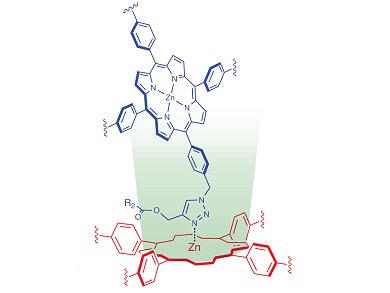The combination of supramolecular chemistry and controlled polymerization to design hierarchically organized polymer architectures for nanotechnology and nanomedicine takes advantage of the low cost, high processability, and modular functionality of synthetic polymers as supramolecular building blocks. Numerous supramolecular recognition motifs have been applied to polymer self-assembly, including hydrogen bonding, metal–ligand coordination, π–π stacking, and host–guest inclusion complexes. Surprisingly, porphyrin-based supramolecular complexes have been largely overlooked for directing polymer self-assembly despite their rich physical properties and well-studied supramolecular chemistry.
Maxwell Crossley, Sébastien Perrier, and co-workers, University of Sydney, Australia, have prepared triazole-linked porphyrin–polymer conjugates by using the copper(I)-catalyzed azide–alkyne cycloaddition reaction. They demonstrated that these conjugates assemble into supramolecular assemblies though porphyrinatozinc–triazole coordination.
The association constant of the supramolecular complex could be tuned by altering the length and grafting density of the polymer arms around the porphyrinatozinc–triazole complex. Furthermore, addition of pyridine as a competitive ligand caused the supramolecular structure to disassemble.
The modular nature of this synthesis provides a platform for the synthesis of functional supramolecular nanostructured materials.
- Tunable Self-Assembly of Triazole-Linked Porphyrin–Polymer Conjugates,
D. A. Roberts, M. J. Crossley, T. W. Schmidt, Sébastien Perrier,
Chem. Eur. J. 2013.
DOI: 10.1002/chem.201301133



![Synthesis of [c2]Daisy Chains via Mechanochemistry](https://www.chemistryviews.org/wp-content/uploads/2025/04/202504_RotaxanesWithSolidStateMechanochemistry-125x94.png)
